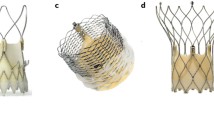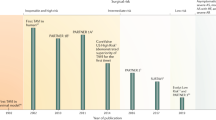Abstract
Senile aortic stenosis (AS), the narrowing and progressive dysfunction of the valve between the heart and the aorta, is the most common structural heart disease in the elderly, with an estimated increase in prevalence from approximately 38.7 million in 2008 to 88.5 million by 2050. The indications for conventional open aortic valve replacement (AVR) utilizing cardiopulmonary bypass remains the standard of care with excellent results. However, physicians remain reluctant to recommend AVR for elderly patients or those considered very high risk. The advent of transcatheter aortic valve intervention (TAVI, transfemoral, and transapical) represents a tremendous advance in our ability to treat high-risk patients with severe AS. By avoiding the risks associated with aortic cross-clamping and cardiopulmonary bypass, it provides a treatment alternative for patients deemed too high risk for conventional AVR. However, this technology is still in the initial stages of clinical use and thus several design challenges and opportunities for improvements in the engineering concepts exist. This paper reviews the outcomes of the two TAVI technologies currently in wide clinical use, the Edwards Sapien® Valve (ESV) and the Medtronic CoreValve® (MCV) and discusses potential improvements in the current design.






Similar content being viewed by others
References
Asimakopoulos, G., M. B. Edwards, and K. M. Taylor. Aortic valve replacement in patients 80 years of age and older: survival and cause of death based on 1100 cases: collective results from the UK Heart Valve Registry. Circulation 96(10):3403–3408, 1997.
Ben-Dor, I., et al. Effects of percutaneous aortic valve replacement on coronary blood flow assessed with transesophageal Doppler echocardiography in patients with severe aortic stenosis. Am. J. Cardiol. 104(6):850–855, 2009.
Bloomstein, L. Z., et al. Aortic valve replacement in geriatric patients: determinants of in-hospital mortality. Ann. Thorac. Surg. 71(2):597–600, 2001.
Bombien, R., et al. Percutaneous aortic valve replacement: computed tomography scan after valved stent implantation in human cadaver hearts. Eur. J. Cardiothorac. Surg. 36(3):592–594, 2009.
Bonow, R. O., et al. ACC/AHA 2006 Guidelines for the management of patients with valvular heart disease: a report of the American College of Cardiology/American Heart Association Task Force on Practice Guidelines (Writing Committee to Revise the 1998 Guidelines for the Management of Patients With Valvular Heart Disease) Developed in Collaboration With the Society of Cardiovascular Anesthesiologists Endorsed by the Society for Cardiovascular Angiography and Interventions and the Society of Thoracic Surgeons. J. Am. Coll. Cardiol., 48(3):e1–e148, 2006
Bramstedt, K. A. Aortic valve replacement in the elderly: frequently indicated yet frequently denied. Gerontology 49(1):46–49, 2003.
Clavel, M. A., et al. Severe valvular regurgitation and late prosthesis embolization after percutaneous aortic valve implantation. Ann. Thorac. Surg. 87(2):618–621, 2009.
Clavel, M. A., et al. Comparison of the hemodynamic performance of percutaneous and surgical bioprostheses for the treatment of severe aortic stenosis. J. Am. Coll. Cardiol. 53(20):1883–1891, 2009.
Cribier, A., et al. Percutaneous transcatheter implantation of an aortic valve prosthesis for calcific aortic stenosis: first human case description. Circulation 106(24):3006–3008, 2002.
Dasi, L. P., et al. Fluid mechanics of artificial heart valves. Clin. Exp. Pharmacol. Physiol. 36(2):225–237, 2009.
Detaint, D., et al. Determinants of significant paravalvular regurgitation after transcatheter aortic valve: implantation impact of device and annulus discongruence. JACC Cardiovasc. Interv. 2(9):821–827, 2009.
Dumont, E., et al. Rapid pacing technique for preventing ventricular tears during transapical aortic valve replacement. J. Card. Surg. 24(3):295–298, 2009.
Filsoufi, F., et al. Excellent early and late outcomes of aortic valve replacement in people aged 80 and older. J. Am. Geriatr. Soc. 56(2):255–261, 2008.
Grube, E., R. Mueller, B. Sauren, B. Zickmann, H. Beucher, T. Felderhoff, S. Iversen, et al. Progress and current status of percutaneous aortic valve replacement: results of three device generations of the CoreValve revaluing system. Circ. Cardiovasc. Intervent. 1:167–175, 2008.
Grube, E., et al. Percutaneous implantation of the CoreValve self-expanding valve prosthesis in high-risk patients with aortic valve disease: the Siegburg first-in-man study. Circulation 114(15):1616–1624, 2006.
Grube, E., et al. Progress and current status of percutaneous aortic valve replacement: results of three device generations of the CoreValve Revalving system. Circ. Cardiovasc. Interv. 1(3):167–175, 2008.
Iung, B., et al. Decision-making in elderly patients with severe aortic stenosis: why are so many denied surgery? Eur. Heart J. 26(24):2714–2720, 2005.
Jilaihawi, H., et al. Predictors for permanent pacemaker requirement after transcatheter aortic valve implantation with the CoreValve bioprosthesis. Am. Heart J. 157(5):860–866, 2009.
Lansac, E., et al. A four-dimensional study of the aortic root dynamics. Eur. J. Cardiothorac. Surg. 22(4):497–503, 2002.
Lansac, E., et al. Aortic root dynamics are asymmetric. J. Heart Valve Dis. 14(3):400–407, 2005.
Lichtenstein, S. V., et al. Transapical transcatheter aortic valve implantation in humans: initial clinical experience. Circulation 114(6):591–596, 2006.
Litzler, P. Y., et al. Surgical aortic valve replacement after percutaneous aortic valve implantation: what have we learned? J. Thorac. Cardiovasc. Surg. 136(3):697–701, 2008.
Maroto, L. C., et al. Delayed dislocation of a transapically implanted aortic bioprosthesis. Eur. J. Cardiothorac. Surg. 36(5):935–937, 2009.
Melby, S. J., et al. Aortic valve replacement in octogenarians: risk factors for early and late mortality. Ann. Thorac. Surg. 83(5):1651–1656, 2007; (discussion 1656–1657).
Nkomo, V. T., et al. Burden of valvular heart diseases: a population-based study. Lancet 368(9540):1005–1011, 2006.
Piazza, N., et al. Procedural and 30-day outcomes following transcatheter aortic valve implantation using the third generation (18 Fr) corevalve revalving system: results from the multicentre, expanded evaluation registry 1-year following CE mark approval. EuroIntervention 4(2):242–249, 2008.
Ross, J., Jr. and E. Braunwald. Aortic stenosis. Circulation 38(1 Suppl):61–67, 1968.
Schultz, C. J., et al. Geometry and degree of apposition of the CoreValve ReValving system with multislice computed tomography after implantation in patients with aortic stenosis. J. Am. Coll. Cardiol. 54(10):911–918, 2009.
Tamburino, C., et al. Procedural success and 30-day clinical outcomes after percutaneous aortic valve replacement using current third-generation self-expanding CoreValve prosthesis. J. Invasive Cardiol. 21(3):93–98, 2009.
Thourani, V. H., et al. Long-term outcomes after isolated aortic valve replacement in octogenarians: a modern perspective. Ann. Thorac. Surg. 86(5):1458–1464, 2008; discussion 1464–1465.
Thubrikar, M., L. P. Bosher, and S. P. Nolan. The mechanism of opening of the aortic valve. J. Thorac. Cardiovasc. Surg. 77(6):863–870, 1979.
Thubrikar, M., et al. Design and dynamic variations of aortic valve leaflets in vivo. Surg. Forum 30:241–243, 1979.
Thubrikar, M., et al. The cyclic changes and structure of the base of the aortic valve. Am. Heart J. 99(2):217–224, 1980.
Ussia, G. P., et al. Quality of life assessment after percutaneous aortic valve implantation. Eur. Heart J. 30(14):1790–1796, 2009.
Walther, T., et al. Transapical minimally invasive aortic valve implantation: multicenter experience. Circulation 116(11 Suppl):I240–I245, 2007.
Walther, T., et al. Transapical aortic valve implantation: step by step. Ann. Thorac. Surg. 87(1):276–283, 2009.
Webb, J. G., et al. Percutaneous transarterial aortic valve replacement in selected high-risk patients with aortic stenosis. Circulation 116(7):755–763, 2007.
Wong, D. R., et al. Mitral valve injury late after transcatheter aortic valve implantation. J. Thorac. Cardiovasc. Surg. 137(6):1547–1549, 2009.
Yoganathan, A. P., Z. He, and S. Casey Jones. Fluid mechanics of heart valves. Annu. Rev. Biomed. Eng. 6:331–362, 2004.
Yoganathan, A. P., et al. Advances in prosthetic heart valves: fluid mechanics of aortic valve designs. J. Biomater. Appl. 2(4):579–614, 1988.
Author information
Authors and Affiliations
Corresponding author
Rights and permissions
About this article
Cite this article
Padala, M., Sarin, E.L., Willis, P. et al. An Engineering Review of Transcatheter Aortic Valve Technologies. Cardiovasc Eng Tech 1, 77–87 (2010). https://doi.org/10.1007/s13239-010-0008-4
Received:
Accepted:
Published:
Issue Date:
DOI: https://doi.org/10.1007/s13239-010-0008-4




